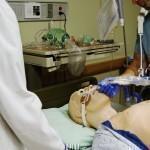The use of high-fidelity simulation manikins for medical education purposes was originally developed in the 1960’s by Dr. Judson Denson and Dr. Stephen Abrahamson at the University of Southern California. Denson and Abrahamson created Sim One, whose purpose was to train anesthesiology residents in endotracheal intubation using patient simulation.
Patient simulation is a technique for hands on practice that educates and improves the competency of healthcare professionals. They discover how to assess, create a treatment plan and provide direct patient care, in mock real world scenarios while under the supervision of an educator. Patient simulation creates an excellent learning environment that reduces potential healthcare accidents and increases skill and confidence of the practitioner.
The need for patient simulation has always been present. However, the initial monetary cost of this new technology was a challenge for most institutions to adopt. But with the advancement in computer hardware, software, and Internet capabilities, as well as an increased demand for hands-on patient simulation, an environment has been developed to make patient simulation more easily accessible through the use of manikins. You might expect that physicians, nurses, and emergency medical professionals can benefit from simulation manikins, but other professionals such as military medical responders can as well.
Arizona College’s Bachelor of Science in Nursing laboratory is equipped with an extensive inventory of simulation manikins. Our nursing students are learning lifesaving skills while demonstrating their knowledge and utilizing the technology of the simulation manikins. The nursing laboratory includes the following manikins, each inducted into the program by the creation of their own “name”:
- 2 High-fidelity manikins
- SimMan3G (Mr. Sherman “Red” Yoder), and
- SimMom (Anita Push)
- 2 Mid-fidelity twin children manikins (Tammy and Tommy Ache)
- 2 Low-fidelity manikins (H. Art Ache and I.M. Hurt)
- 3 Mid-fidelity manikins (Paris Stalsis, Ima Enpain, and Anita Waters)
Fidelity, which is classified as high, mid, or low, refers to how much realism the manikin has.
- A High-fidelity manikin moves with respiration, blinks it’s eyes, has heart, lung and bowel sounds. It has pulses all over the body and the instructor can speak through the manikin communicating verbally with the nursing student for assessment exercises.
- Anita Push (Sim Mom), can give birth, hemorrhage, urinate and simulate a variety of obstetrical complications.
- Sherman “Red” Yoder can sweat, cry, drool, urinate and bleed. These life-like characteristics of the simulation manikins result in a real world educational experience.
- The Mid-fidelity manikins provide lung, heart and bowel sounds as well as blood pressure and pulses in one arm. They do not move with these sounds and they do not blink.
- The Low-fidelity manikins are primarily task trainers. They do not make any sounds, but are excellent for practicing psychomotor, affective and cognitive skills.
Arizona College’s Bachelor of Science in Nursing students have the opportunity to apply the nursing skills and techniques they are learning by utilizing the technology of simulation manikins. Simulation during lab builds the skill-set and confidence of the nursing student, and the process of role play in a group setting helps students to develop team building skills that will be needed when treating patients in the healthcare environment. If you are interested in exploring the possibility of becoming a Registered Nurse, contact Arizona College. Complete a form to request more information, and take a tour of the campus and nursing labs. Take the first step in becoming a Registered Nurse and your new rewarding career!
Information in this blog post is accurate as of June 12, 2015.

